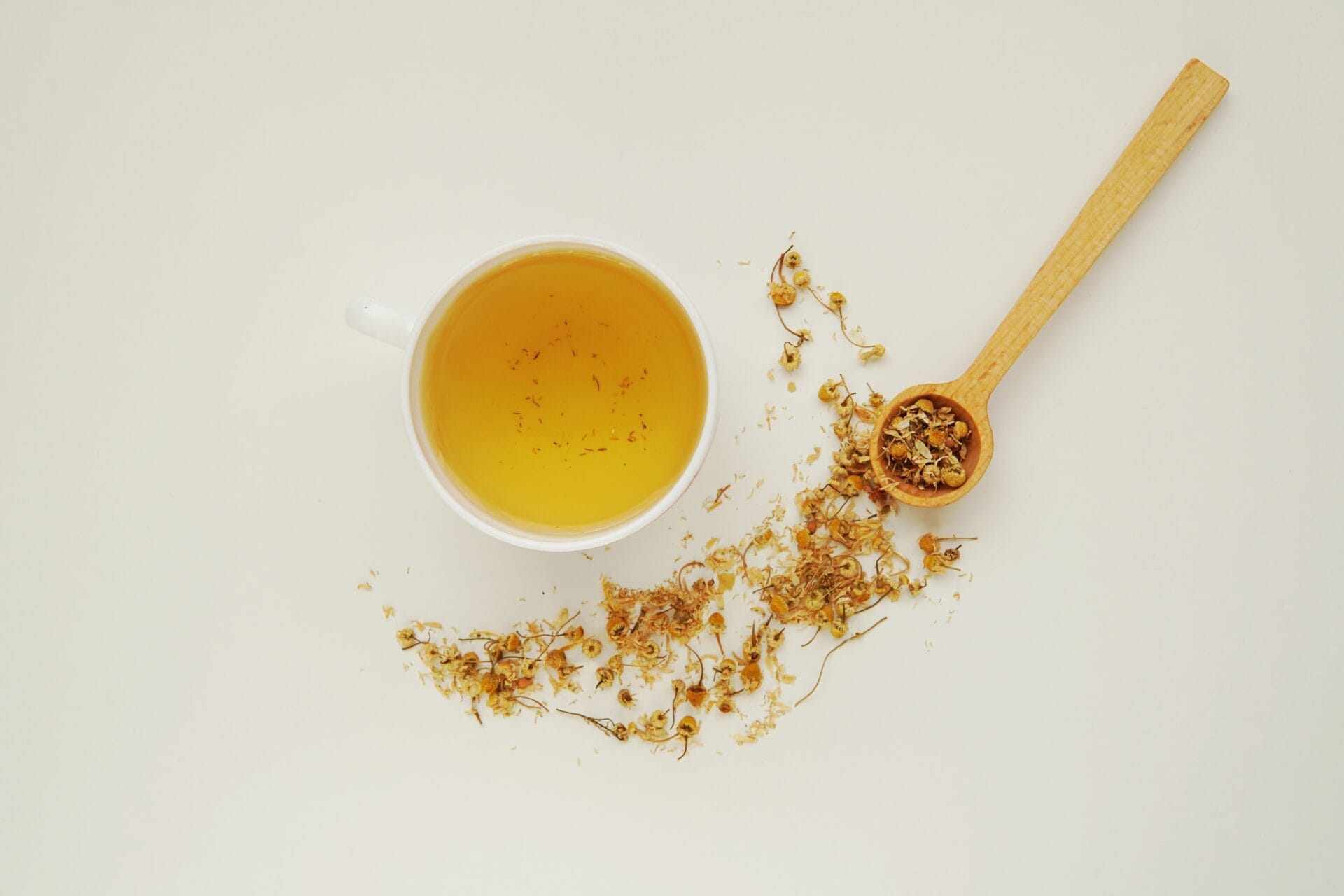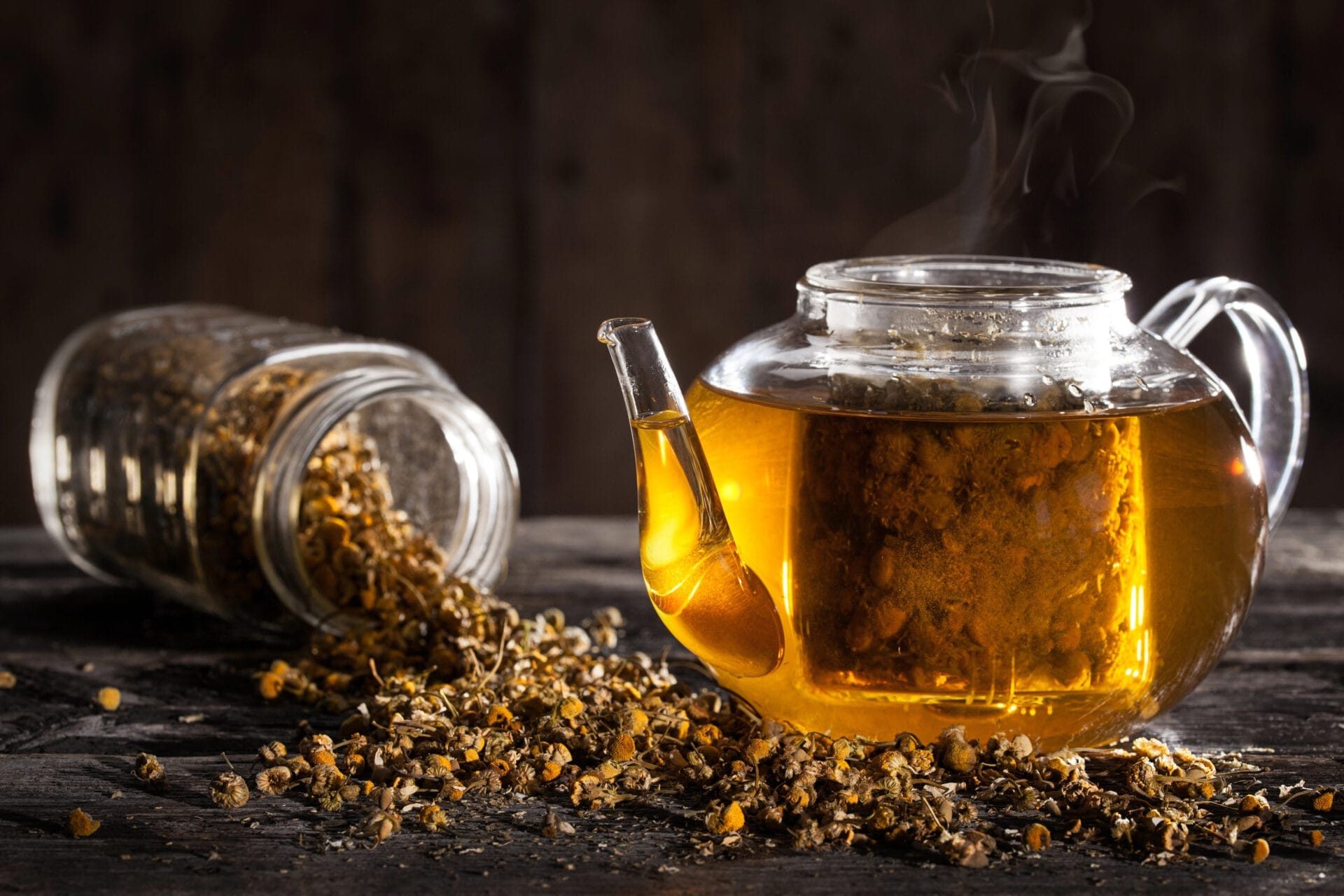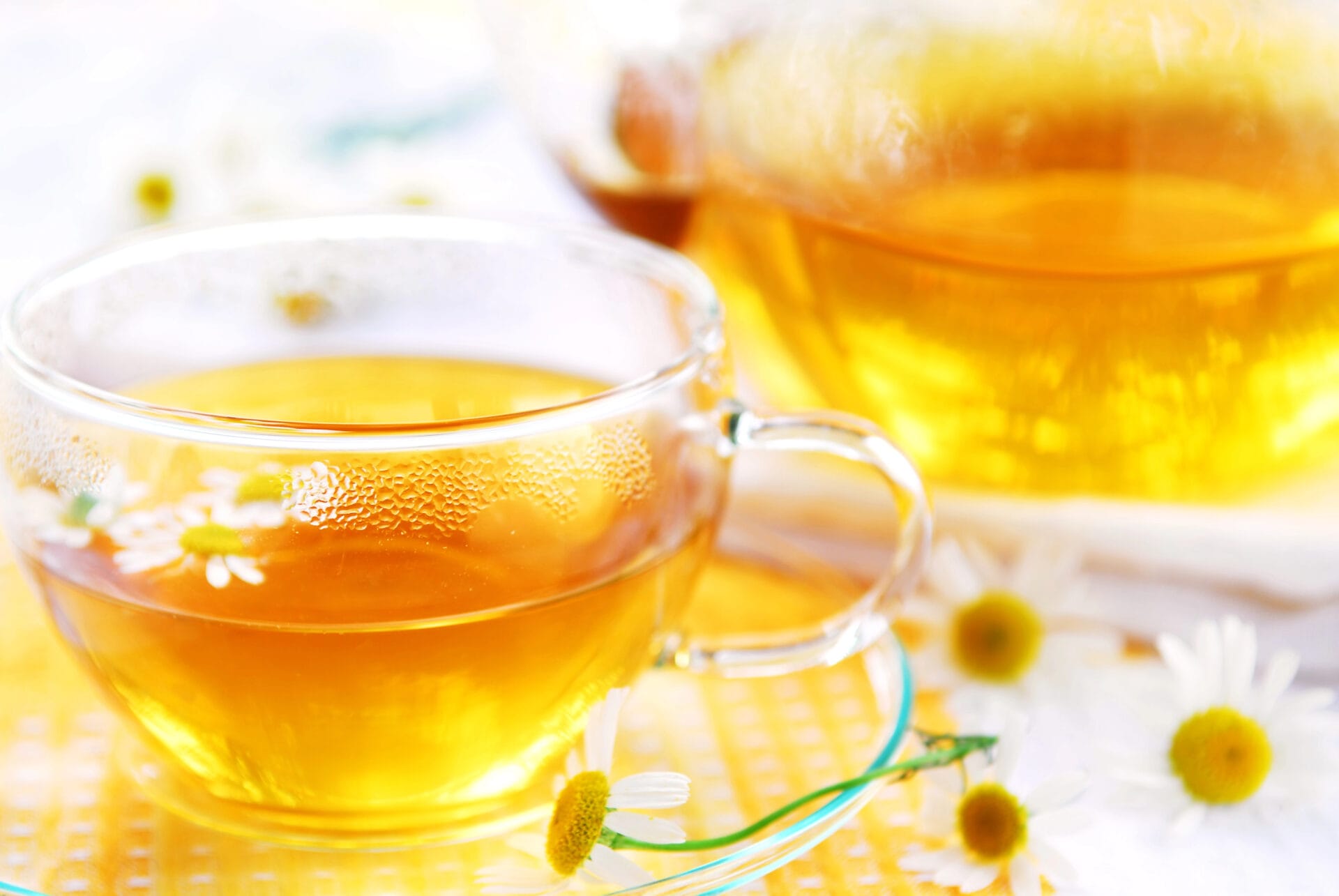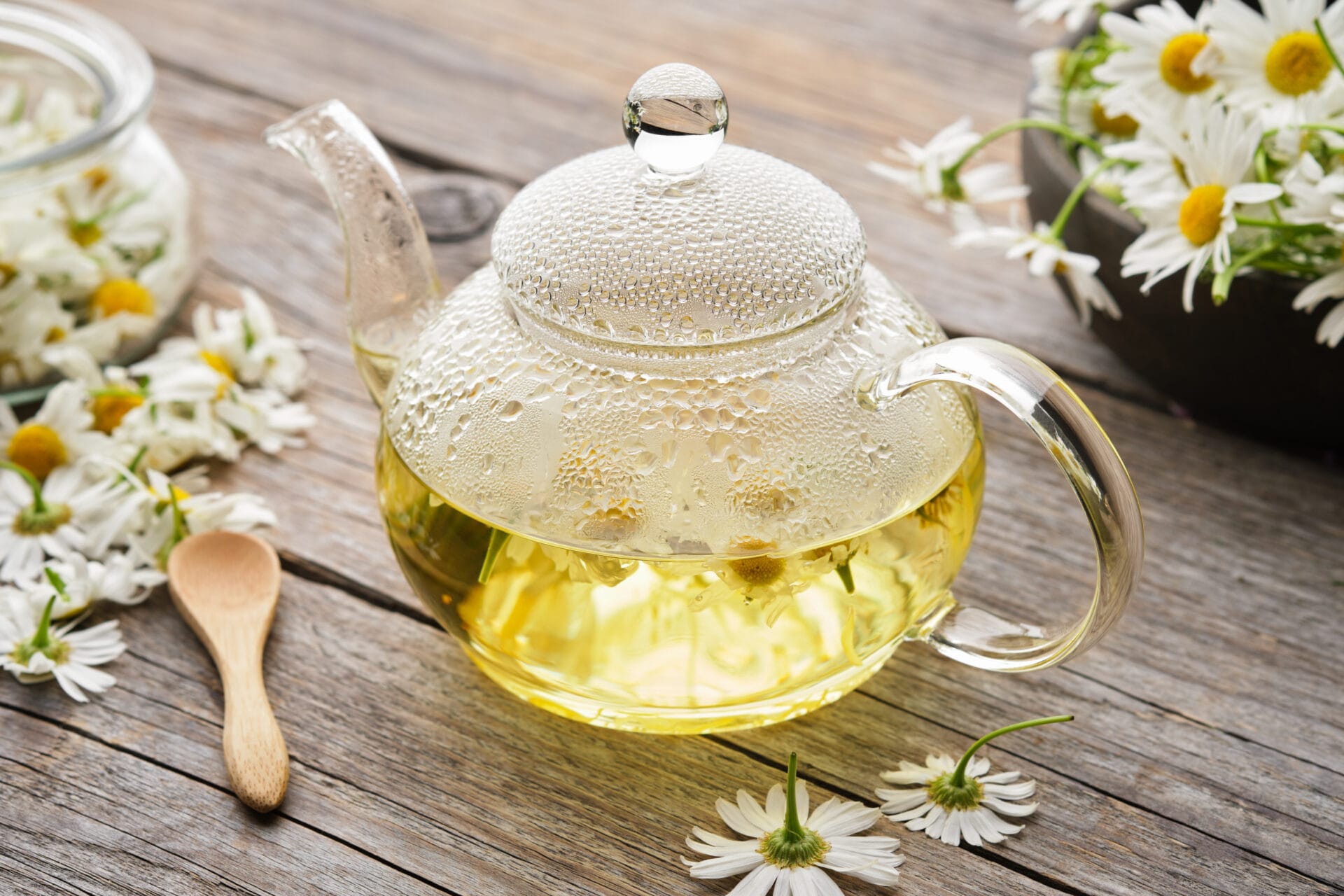Which Chamomile Teas do not have PFAS “forever chemicals” inside the tea leaves? This is the question we attempted to answer when we sent the most popular chamomile tea brands used inside our community to an EPA-certified laboratory to (1) have the tea leaves tested for 40 PFAS analytes and then (2) have the tea bags tested for total fluorine. You’ve trusted Mamavation to bring you consumer studies like safest olive oils tested for phthalates, safest coffee tested for PFAS, mycotoxins, & pesticides, safest water filters, & safest cookware, now join us for our latest study testing popular chamomile teas for forty specific PFAS compounds.
Disclosure: This consumer study is released in partnership with Environmental Health News. Scientific reviews were performed by (1) Linda S. Birnbaum, Scientist Emeritus and Former Director of the National Institute of Environmental Health Sciences and National Toxicology Program & Scholar in Residence at Duke University, Adjunct Professor at the University of North Carolina, & Yale University, (2)Terrence Collins, Teresa Heinz Professor of Green Chemistry & Director of the Institute for Green Sciences at Carnegie Mellon University This post was medically reviewed by Sondra Strand, RN, BSN, PHN. Donations were provided by Environmental Health News and Mamavation community members. Note that Mamavation has only “spot-checked” the industry and thus we cannot make predictions about brands and products that we have not tested. Products and manufacturing aides can change without notice so buyer beware. This post contains affiliate links, with some to Amazon, which means Mamavation will receive a portion of those sales and we will use that to pay ourselves back for the testing. You can also give a tax-deductible donation to our consumer studies here through Environmental Health Sciences. Thank you! Copyright © 2025 Mamavation — All Rights Reserved

Table of Contents
Traces of PFAS “Forever Chemicals” Were Found in Most Chamomile Tea Leaves
Mamavation’s EPA-certified laboratory found per- and polyfluoroalkyl substances (PFAS “forever chemicals”) in 13 popular chamomile tea leaves. These chemicals are linked to serious health effects, which we will discuss later. Because PFAS “forever chemicals” are so problematic to normal hormone action, Mamavation has commissioned our own scientific studies on PFAS in food products to make recommendations for the safest chamomile teas. Continue reading Mamavation’s article on these products to find which brands have the safest chamomile tea according to our laboratory.
For this consumer study, Mamavation sent 13 popular chamomile teas from 13 brands to an EPA-certified laboratory looking for specific PFAS compounds. We had both the tea bags and the tea leaves tested. The tea leaves were tested for 40 PFAS analytes and the tea bags were tested for total fluorine. Because Mamavation only tested one product per brand, we cannot claim to know if these issues are, in fact, industry-wide or brand-wide. However, based on our “spot-check” of the industry, this is what we found:
- 54% of chamomile tea leaves had detectable PFAS “forever chemicals” according to our lab. That’s 7 out of 13 chamomile tea brands tested had PFAS.
- 31% of chamomile tea leaves had quantifiable levels of PFAS “forever chemicals” according to our lab. This means the levels of PFAS found were high enough to quantify. That’s 4 out of 13 chamomile tea brands.
- The most common type of PFAS found by our lab was PFBA, (Perfluorobutanoic acid.)
- Ranges of PFBA: 0.32 ng/g to 2.37 ng/g. ng/g is parts per billion (ppb).
- 23% of tea bags tested by our lab had total fluorine levels, a combination of inorganic fluoride and potential PFAS. That’s 3 out of 13 tea bags.
- The levels of total fluorine inside the tea bags were between 10 ppm and 16 ppm.
Linda S. Birnbaum, Scientist Emeritus and Former Director of the National Institute of Environmental Health Sciences and National Toxicology Program & Scholar in Residence at Duke University, Adjunct Professor at the University of North Carolina, & Yale University had this to say: “It’s disappointing to find PFAS inside Chamomile Tea. This relaxing tea is used by millions of people around the world, and exposure to these hormone-disrupting chemicals is very problematic to human health. Let’s hope these companies address this issue.”

PFAS “Forever Chemicals” Have Problematic Health Effects
PFAS “forever chemicals” are problematic for human health and the environment. They are considered ubiquitous, persistent, and toxic. Therefore, it’s imperative to reduce the amount of PFAS you are exposed to from food, water, and other beverages like tea. Mamavation is dedicated to helping you do that when you are shopping for tea.
Here are some of the health effects of different PFAS “forever chemicals:”
- Reduction in immunity
- Reduced vaccination response
- Increased risk of allergies & asthma in young children
- Affected growth, learning, and behavior of infants and older children
- Increase cholesterol levels
- Metabolic diseases like obesity & diabetes
- Cardiovascular disease
- Lowered a woman’s chance of getting pregnant
- Lowered male fertility
- Increased risk of kidney & testicular cancers
- Causes endocrine disruption
- Disrupted normal thyroid function
- Increases risk of acute lymphoblastic leukemia in children
It’s also very clear based on biomonitoring evidence from the Centers for Disease Control & Prevention (CDC) that PFAS are in all Americans. Therefore, these exposures can harm most Americans.
Specific PFAS Found by Mamavation’s Laboratory
Mamavation’s laboratory found two specific PFAS chemicals within the chamomile tea leaves. Although we were not able to get specific details of where each brand’s sourcing farms were located, most of the geographic regions sourced from based on marketing materials and customer service inquiries were in Egypt. These chemicals are listed as the most commonly found in our study. In other words, the most commonly found was Perfluorobutanoic acid (PFBA).
- PFBA: Perfluorobutanoic acid (PFBA) is a breakdown chemical of other PFAS used in stain-resistant fabrics, paper food packaging, and carpets. PFBA was also used for manufacturing photographic film. 3M Company was once a major manufacturer of PFBA and products containing PFBA, but production was phased out in 1998. PFBA continues to be produced by multiple companies in the US and other parts of the world. Exposure to high levels of PFBA resulted in thyroid and liver effects, such as increased thyroid, changes in thyroid hormones, and decreased cholesterol in animal studies. Many PFAS do not break down in the environment via natural processes and are commonly referred to as “forever chemicals” because of their status as a persistent organic pollutant (POP). PFBA is known to move through the environment and contaminate drinking water and soil as it bioaccumulates. Residues have been consistently found worldwide in wildlife, humans, and the environment.
- 6:2FTS: 6:2-Fluorotelomersulfonic acid (6:2FTS) is a replacement chemical for perfluorooctanesulfonic acid (PFOS) used in fire-fighting foams and chromium plating. Although 6:2FTS has not been studied intensively, such “short-chain” PFAS chemicals have already become very persistent in the environment and can get into places where they were not expected to be found.

Recent Studies on PFAS in Teas Have Demonstrated Widespread Contamination
The past five years have seen a flurry of studies looking at specific PFAS compounds and certain foods and beverages like tea. We could not find a study that looked specifically at chamomile teas, however, many other types of tea like green tea have been studied and found to contain certain types of PFAS. In fact, one study claimed that people who drank more tea were more likely to have higher levels of PFAS in their blood. Here are some recent examples of studies done on teas:
- In a study published in 2023, tea bags coming from India were found to contain PFOS, PFHxS, and PFuNA present in the tea bag powder and tea bag material.
- In a study published in 2022, bubble tea was found to contain certain PFAS compounds at concerning levels.
- In a Japanese study published in 2021, PFAS was found in Japanese teas, among other products like bottled water and juice.
- Another study in 2021 found specific PFAS compounds in beer and tea.
- A study in 2020 found that coffee/tea was associated with higher plasma concentrations of specific PFAS as well.
- Mamavation found detectable PFAS in 91% of the Earl Grey Teas sampled.
Because tea is an everyday product used by millions of families in the United States, Mamavation wanted to establish which chamomile tea brands would be considered the “safest” in terms of PFAS. The results of our Earl Grey Tea study are here.
Terrence Collins, Teresa Heinz Professor of Green Chemistry & Director of the Institute for Green Sciences at Carnegie Mellon University had this to say about the study: “This study looks at an important question in the interests of chamomile tea drinkers. Are there chemicals that might elicit low-dose toxicity in the tea or bagging where PFAS contaminants are among the most troubling compounds one would want to see? The results speak for themselves. The comforting part is that PFAS contamination is not universal, at least in Mamvation’s spot-testing. Chamomile tea drinkers are now armed with the knowledge to send messages of approval or disapproval through their buying habits across the chamomile business world.”

Some Tea Bags Tested by Mamavation’s Lab Tested Were Found to Contain Fluorine
To test the tea sachets, we looked for a broad category of fluorine-containing chemicals instead of testing only for organic fluorine. The testing had some limitations when fluoride was present, but this is not considered as big of an issue with chamomile tea. So we are reporting the results in total fluorine instead of organic fluorine, which is a combination of both organic fluorine and inorganic fluoride. This means the results would include potential inorganic fluoride from the tea leaves rubbing up against the tea sachets and also indications of PFAS “forever chemicals” together.
Total fluorine can be a good indicator of PFAS “forever chemicals.” According to Scott Belcher, Associate Professor with the Center for Environmental & Health Effects of PFAS at North Carolina State University, “the chemical testing methods used evaluate the fluorine in the samples, by converting the fluorine found in PFAS and some medications to fluoride. Detecting excess amounts of fluoride, a common mineral, suggests the presence of PFAS and other synthetic fluorinated chemicals, which can include inorganic fluoride.”

Mamavation’s Investigation of Chamomile Tea and 40 Analyte PFAS Testing
Chamomile Tea was purchased around December 2024. Each product was recorded in our database and then sent directly to the lab within its original packaging.
Testing Loose Leaf Tea: Mamavation’s EPA-certified laboratory used method EPA 1633 to test for 40 PFAS compounds, including the following:
- Perflurobutanoic acid (PFBA)
- Perfluoropentanoic acid (PFPeA)
- Perfluorohexanoic acid (PFHxA)
- Perfluoroheptanoic acid (PFHpA)
- Perfluorooctanoic acid (PFOA)
- Perfluorononanoic acid (PFNA)
- Perfluorodecanoic acid (PFDA)
- Perfluoroundecanoic acid (PFUnA)
- Perfluorododecanoic acid (PFDoA)
- Perfluorotridecanoic acid (PFTrDA)
- Perfluorotetradecanoic acid (PFTeDA)
- Perfluorobutanesulfonic acid (PFBS)
- Perfluoropentansulfonic acid (PFPeS)
- Perfluorohexanesulfonic acid (PFHxS)
- Perfluoroheptanesulfonic acid (PFHpS)
- Perfluorooctanesulfonic acid (PFOS)
- Perfluoronanesulfonic acid (PFNS)
- Perfluorodecanesulfonic acid (PFDS)
- Perfluorododecanesulfonic acid (PFDoS)
- 1H,1H, 2H, 2H-Perfluorohexane sulfonic acid (4:2FTS)
- 1H,1H, 2H, 2H-Perfluorooctane sulfonic acid (6:2FTS)
- 1H,1H, 2H, 2H-Perfluorodecane sulfonic acid (8:2FTS)
- Perfluorooctanesulfonamide (PFOSA)
- N-methyl perfluorooctanesulfonamide (NMeFOSA)
- N-ethyl perfluorooctanesulfonamide (NEtFOSA)
- N-methyl perfluorooctanesulfonamidoacetic acid (NMeFOSE)
- N-ethyl perfluorooctanesulfonamidoethanol (NEtFOSE)
- Hexafluoropropylene oxide dimer acid (HFPO-DA)
- 4,8-Dioxa-3H-perfluorononanoic acid (ADONA)
- Perfluoro-3-methoxypropanoic acid (PFMPA)
- Perfluoro-4-methoxybutanoic acid (PFMBA)
- Nonafluoro-3,6-dioxaheptanoic acid (NFDHA)
- 9-Chlorohexadecafluoro-3-oxanonane-1-sulfonic acid (9CI-PF3ONS)
- 11-Chloroeicosafluoro-3-oxaundecane-1-sulfonic acid (11CI-PF3OUdS)
- Perfluoro(2-ethoxyethane)sulfonic acid (PFEESA)
- 3-Perfluoropropyl propanoic acid (3:3FTCA)
- 2H,2H,3H,3H-Perfluorooctanoic acid (5:3FTCA)
- 3-Perfluoroheptyl propanoic acid (7:3FTCA)
Testing Tea Bags: Mamavation’s EPA-certified laboratory uses marker testing to identify the potential presence of PFAS “forever chemicals” in tea sachets. Total fluorine is a marker for PFAS because all PFAS chemicals are carbon-based compounds that contain fluorine. The specific lab method used to test for total fluorine was the Determination of Total Fluorine by Oxygen Flask Combustion and Ion-Selective Electrode. This marker testing is likely to show the presence of PFAS. In addition to inorganic fluoride, fluorine also captures other fluoropolymers, pharmaceuticals, and common hydrofluorocarbon refrigerants, such as 1,1,1,2-tetrafluoroethane (commonly known as R-134a) and 2,3,3,3-tetrafluoropropene (commonly known as HFO-1234yf). These are all also PFAS.

Not Our Favorite Chamomile Tea
These products were sent off to an EPA-certified laboratory. The tea leaves were tested for 40 PFAS analytes and each product had positive results. The tea bags were tested for fluorine, a marker of PFAS “forever chemicals.”
- Bigelow Cozy Chamomile Herbal Tea — Tea Leaves: 2.37 PFBA ng/g, Tea Bag: Non-detect fluorine.
- Numi Organic Herbal Teasan Chamomile Lemon Sweet Flowers & Lemon Myrtle Tea — Tea Leaves: 0.78 PFBA ng/g & 0.478 6:2FTS ng/g, Tea Bag: Non-detect fluorine.
- PUKKA Chamomile, Vanilla, & Manuka Honey Blissful Calm Organic Tea — Tea Leaves: 0.32 PFBA ng/g, Tea Bag: Non-detect fluorine.
- Traditional Medicinals Organic Chamomile Supports Relaxation Tea — Tea Leaves: 0.97 PFBA ng/g, Tea Bag: Non-detect fluorine.
Better Chamomile Tea
These products were sent off to an EPA-certified laboratory. The tea leaves were tested for 40 PFAS analytes and each product had positive results, however, the results were so small they were not quantifiable. The tea bags were tested for fluorine, a marker of PFAS “forever chemicals.” We also included one brand that did not have detectable PFAS, but had detectable fluorine in their tea bags.
- The Republic of Tea Super Herb Tea Organic Egyptian Chamomile — Tea Leaves: <MRL PFBA, Tea Bag: Non-Detect total fluoride.
- STASH Chamomile Caffeine-Free Herbal Tea — Tea Leaves: <MRL PFBA, Tea Bag: 16 ppm total fluorine
- Twinings Pure Camomile Pure Herbal Tea — Tea Leaves: <MRL 6:2FTS, Tea Bag: Non-detect total fluorine
- Yogi Comforting Chamomile Soothes Mild Tension Tea — Tea Leaves: Non-Detect PFAS, Tea Bag: 10 ppm total fluorine
Best Chamomile Tea
These products were sent off to an EPA-certified laboratory. The tea leaves were tested for 40 PFAS analytes and each product had non-detect results. The tea bags were tested for fluorine, a marker of PFAS “forever chemicals,” and also had non-detect results.
- Celestial Seasonings Chamomile Herbal Tea — Tea Leaves: Non-detect PFAS, Tea Bag: Non-detect total fluorine
- From Great Origins (FGO) Organic Chamomile Tea Bags — Tea Leaves: Non-detect PFAS, Tea Bag: Non-detect total fluorine
- RISHI Chamomile Medley Organic Botanical Blend Tea Sachet — Tea Leaves: Non-detect PFAS, Tea Bag: Non-detect total fluorine (Use discount code “MAMAVATION15” for 15% off products!)
- Taylors of Harrogate Organic Chamomile Caffeine-Free Herbal Infusion Tea — Tea Leaves: Non-detect PFAS, Tea Bag: Non-detect total fluorine
- TAZO Organic Calm Chamomile Herbal Tea — Tea Leaves: Non-detect PFAS, Tea Bag: Non-detect total fluorine





 Best (& Worst) Organic Infant Formulas — Cow’s Milk, Goat Milk, & Specialty
Best (& Worst) Organic Infant Formulas — Cow’s Milk, Goat Milk, & Specialty
Bonomelli is a well-known chamomile tea brand from Italy, recognized for using the entire top of the chamomile flower to create a rich and soothing herbal tea. Their products are caffeine-free and are often enjoyed for their relaxing properties.
This research really opened my eyes — I never imagined something as soothing as chamomile tea could hide such harmful “forever chemicals.” It’s a reminder to stay mindful about what we consume daily. 🌿 I truly appreciate the awareness this brings.
By the way, if you love exploring helpful and reliable online tools, you might enjoy terraboxlink — it’s perfect for safely saving and managing videos or guides like this for later reading.
chamomile tea is good for cramps in periods…..
This is great information! I’d be interested if you test any additional protein products in the future. A very popular one right now seems to be the Clean Simple Eats Protein powder.
What is name of tge one from italy
I drink the original Chamomile tea from Italy. Since age 18. Now 70.
What is name of tge one from italy
Hello! Been trying to click on different blogs/posts and keep getting kicked into WordPress on your site. I didn’t have this problem last week, or months prior.
Bonomelli is a well-known chamomile tea brand from Italy, recognized for using the entire top of the chamomile flower to create a rich and soothing herbal tea. Their products are caffeine-free and are often enjoyed for their relaxing properties.
What about thrive market’s organic chamomile tea?
Is there a similar test for dandelion root teas?
What of “LORDS” brand of Carmomile tea? Did it go through your test? I have been drinking the brand.
Thank you for your wonderful work in consumer education.
Hi, how about LIPTON CHAMOMILE TEA? Did you detect Flofluorine?
I am using this brand.
Will Tea pigs be tested in the future?
Hi! Thanks for all this info on teas. I am a big drinker of teas so appreciate your tireless work.
One issue though:
The best teas listed above have been found to have microplastics in their bags. Even those clsiming to use plant based materials. Celestial Seasonings for one.
I guess we do our best. PFAS vs Microplastics? Crazy that it comes to this.
What about Equal Exchange or Frontier Market? I think they trst.
Agreed. I also thought Celestial Seasonings tested as one of the teas with the highest concentration of pesticide residues on their products.
Can’t win for losing, apparently.
I would love to know more about Buddha teas. 90% of my teas are purchased through them.
Did you test Fraser brand?
I did not see Buddha Yeas Organic Chamomile tea tested..any information ? That’s the brand I buy. Thank you. I’m an Elder wishing you blessings on your Sacred Journey 🙏🦋❤️
How about Buddha tea?